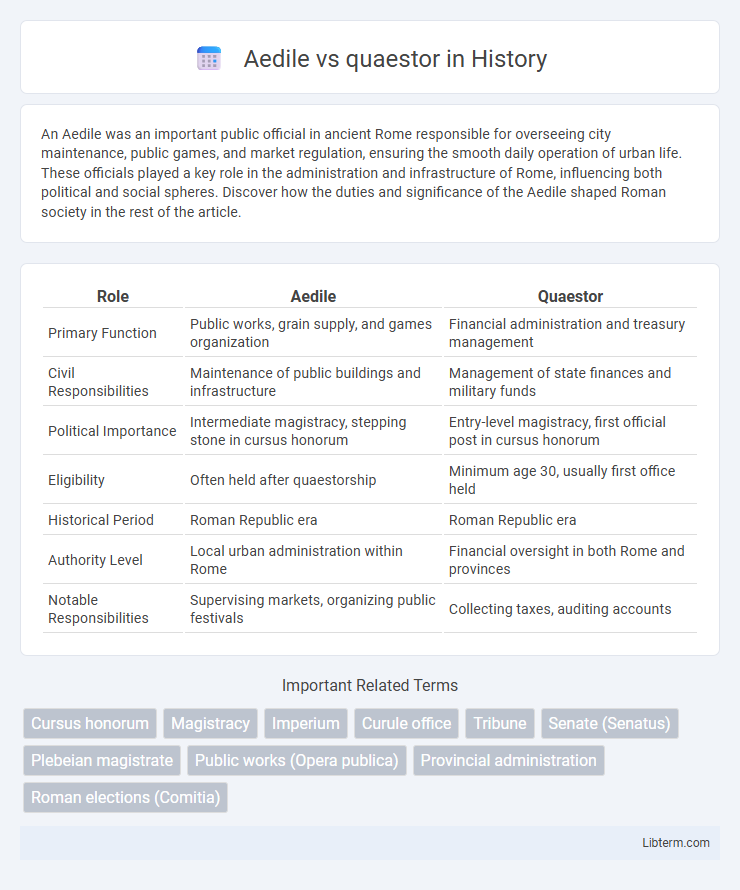An Aedile was an important public official in ancient Rome responsible for overseeing city maintenance, public games, and market regulation, ensuring the smooth daily operation of urban life. These officials played a key role in the administration and infrastructure of Rome, influencing both political and social spheres. Discover how the duties and significance of the Aedile shaped Roman society in the rest of the article.
Table of Comparison
| Role | Aedile | Quaestor |
|---|---|---|
| Primary Function | Public works, grain supply, and games organization | Financial administration and treasury management |
| Civil Responsibilities | Maintenance of public buildings and infrastructure | Management of state finances and military funds |
| Political Importance | Intermediate magistracy, stepping stone in cursus honorum | Entry-level magistracy, first official post in cursus honorum |
| Eligibility | Often held after quaestorship | Minimum age 30, usually first office held |
| Historical Period | Roman Republic era | Roman Republic era |
| Authority Level | Local urban administration within Rome | Financial oversight in both Rome and provinces |
| Notable Responsibilities | Supervising markets, organizing public festivals | Collecting taxes, auditing accounts |
Introduction to Aedile and Quaestor
Aediles were Roman magistrates responsible for public buildings, games, and the city's grain supply, playing a key role in urban management and public order. Quaestors handled financial administration, managing the state treasury, military funds, and public accounts, serving as the first step in a political career. Both offices formed essential parts of the Roman Republic's cursus honorum, with Quaestors focusing on finances and Aediles on civic duties.
Historical Origins of Aediles and Quaestors
Aediles and quaestors trace their origins to the Roman Republic, with quaestors serving as the earliest financial magistrates responsible for managing the public treasury and military funds. Aediles emerged later as officials overseeing urban maintenance, public games, and market regulation, reflecting Rome's expanding civic infrastructure. These offices evolved to balance fiscal oversight by quaestors with municipal administration by aediles, shaping Rome's complex political system.
Core Duties of an Aedile
Aediles were responsible for maintaining public buildings, overseeing markets, and organizing public games and festivals in ancient Rome. Their core duties included ensuring the city's infrastructure was functional, regulating commerce, and enforcing public order. Unlike quaestors who managed financial matters, aediles focused on urban administration and public welfare.
Primary Responsibilities of a Quaestor
Quaestors primarily managed financial affairs and treasury duties in ancient Rome, overseeing public funds and state expenditures. Unlike Aediles who were responsible for public infrastructure, markets, and festivals, quaestors handled fiscal accountability and supervised officials managing city finances. Their role was critical in supporting magistrates with financial administration and maintaining the economic stability of the Republic.
Election Processes and Eligibility
Aediles and quaestors were elected magistrates in ancient Rome, each requiring candidates to meet specific age and social class criteria set by the cursus honorum. Quaestors, typically the entry-level office, required candidates to be at least 30 years old and often served as financial administrators. Aediles, responsible for public works and games, were usually elected after serving as quaestors and needed to have completed prior political roles to ensure experience and eligibility.
Powers and Authority: Aedile vs Quaestor
Aediles held significant powers over public games, market regulation, and urban maintenance, including the authority to enforce laws related to city infrastructure and public order. Quaestors primarily managed financial administration, overseeing the treasury, state funds, and accounts of military campaigns, but lacked legislative or policing authority. The distinction in authority highlights the Aedile's role in civic management and public service, contrasted with the Quaestor's focus on fiscal responsibilities within the Roman Republic.
Role in Public Administration
Aediles were responsible for maintaining public infrastructure, regulating markets, and organizing festivals in ancient Roman cities, ensuring proper urban management and civic order. Quaestors managed the financial affairs of the state, including the treasury, military finances, and public expenditures, playing a crucial role in fiscal administration. Both offices were essential in the Roman Republic's administrative hierarchy, with Aediles focusing on urban and social regulation while Quaestors handled financial governance.
Career Advancement: Political Significance
The aedile held greater political significance than the quaestor due to responsibilities involving public works, games, and urban maintenance, which offered higher visibility and opportunities to gain popular support. Quaestors primarily managed financial administration, serving as an entry-level position with limited public exposure. Advancing from quaestor to aedile marked a notable career progression, enhancing political influence and paving the way toward higher offices such as praetor or consul.
Impact on Roman Society
Aediles played a crucial role in maintaining public order by overseeing markets, public games, and urban infrastructure, directly influencing daily life and social cohesion in Roman cities. Quaestors managed the financial administration of the state, ensuring efficient allocation of resources which supported military campaigns and public projects, thereby stabilizing Rome's economic foundation. Both offices contributed to the functioning of the Republic, with aediles fostering civic engagement and quaestors underpinning fiscal responsibility.
Conclusion: Comparing Aedile and Quaestor
Aediles were responsible for urban maintenance, public games, and market regulation, emphasizing city management and civic amenities. Quaestors primarily managed financial administration, including treasury oversight and funds disbursement for military and public expenses. Comparing Aedile and Quaestor highlights a division between public service focused on infrastructure and entertainment versus fiscal responsibilities crucial for Rome's governance.
Aedile Infographic

 libterm.com
libterm.com